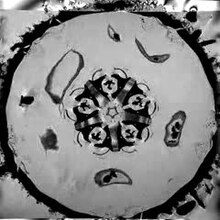Beach urchins
| Beach urchins | ||||||||||||
|---|---|---|---|---|---|---|---|---|---|---|---|---|

Beach sea urchin ( Psammechinus miliaris ) |
||||||||||||
| Systematics | ||||||||||||
|
||||||||||||
| Scientific name | ||||||||||||
| Psammechinus miliaris | ||||||||||||
| ( PLS Müller , 1771) |
The beach sea urchin ( Psammechinus miliaris ) is in the North Sea and the Atlantic coast of Western Europe common sea urchins .
features
Psammechinus miliaris has a dorsoventrally flattened body with an often approximately pentagonal outline and a diameter of up to 5 cm, but mostly about 3.5 cm and a greenish coloration of both the housing and the spines, the tips of the latter mostly in a species-typical manner are colored purple. The case has a rather small apical system, and the mouth field is densely covered with thick plates on which there are numerous pedicellariums , but no spines. Each ambulacral plate has three pairs of pores. The housing is densely covered with spines of almost the same length, in which the primary spines are not noticeable compared to the secondary spines formed later. On the bare case, however, one can clearly see the rows of nodules for the primary spines. The interambulacral plates are each provided with three nodules, each of which has a spine, the larger, middle nodule carrying the primary spine; So there is a primary spine on each interambulacral plate. The globiferous pedicellarians are small, usually very numerous, and have forceps with rather wide, open outer parts. On each side of the forceps there is a row of teeth on their thin edges that are not connected by cross bars. The powerful three-toothed pedicellarians, on the other hand, have wide, leaf-like forceps.
distribution and habitat
The sea urchin is common in the North Sea and in the eastern Atlantic Ocean on the coasts of Western Europe from Iceland to Morocco . It is absent from the coasts of America, Greenland and the Mediterranean.
Psammechinus miliaris lives in the intertidal zone and down to a depth of 100 m, especially on rocky substrates, at greater depths also in sea grass meadows and on sandy or muddy subsoil.
Psammechinus miliaris can reach high population densities, for example in a seagrass meadow with Zostera marina off the west coast of Scotland , where 182 sea urchins per square meter were found, compared to 28 in the neighboring muddy sediment.
Reproduction
The sea urchin is segregated, and the females and males come together in spring and early summer. A female suddenly releases around 80,000 to 2.5 million, which are fertilized by the male's sperm in the open sea water. The free-swimming Echinopluteus larvae form part of the zooplankton until they sink to the bottom after one to two months and metamorphose into sea urchins .
nutrition
Psammechinus miliaris is an omnivore and uses its Aristotle lantern to graze on algae and also prey on sessile or slow-moving animals, including polychaetes such as Polydora ciliata , sessile hydrozoans , barnacles and various other small crustaceans , small clams , diatoms and brown algae but also carrion and detritus . Sugar kelp ( Saccharina latissima ) is one of his favorite plant foods, and he eats it both fresh and rotten, but fresh kelp lingers longer in the sea urchin's intestinal tract because of its more difficult digestibility. It has a considerable influence on the population dynamics of various animal and plant species, such as the multi- bristle species Pomatoceros triqueter and various types of algae that it eats. A single sea urchin can eat around 8 to 12 barnacles ( Semibalanus balanoides ) or 6 mussels ( Mytilus edulis ) in a day .
Use by humans
The gonads of both females and males are primarily eaten by humans . The sea urchins are collected on the European coasts, but research is also being carried out into aquaculture possibilities.
literature
- Maeve S. Kelly, Adam D. Hughes, Elizabeth J. Cook: Ecology of Psammechinus miliaris. In: John M. Lawrence: Edible Sea Urchins: Biology and Ecology. Elsevier, Amsterdam 2007. pp. 287-295. ISBN 0-86622-875-6 .
- MS Kelly (2000): The reproductive cycle of the sea urchin Psammechinus miliaris (Echinodermata: Echinoidea) in a Scottish sea loch. Journal of the Marine Biological Association of the United Kingdom 80, pp. 909-919.
Web links
- Beach urchins . In: Lexicon of Biology , online edition.
- MJ de Kluijver, SS Ingalsuo: Shore Sea Urchin - Psammechinus miliaris (Gmelin, 1778). Macrobenthos of the North Sea - Echinodermata, Marine Species Identification Portal
- A. Jackson: Green sea urchin - Psammechinus miliaris (PLS Müller, 1771). In: H. Tyler-Walters, K. Hiscock (Eds.): Marine Life Information Network, Biology and Sensitivity Key Information Reviews. Marine Biological Association of the United Kingdom, Plymouth 2008.
Individual evidence
- ↑ CA Comely: Observation on two Scottish West coast populations of Psammechinus miliaris. Scottish Marine Biological Association, Internal Report, Oban 1979.
